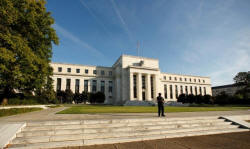|
Fed likely to keep rates
steady as it awaits Trump economic plan
 Send a link to a friend
Send a link to a friend
 [January 31, 2017]
By Lindsay Dunsmuir [January 31, 2017]
By Lindsay Dunsmuir
WASHINGTON
(Reuters) - The U.S. Federal Reserve is expected to keep interest rates
unchanged on Wednesday in its first policy decision since President
Donald Trump took office, as the central bank awaits greater clarity on
his economic policies.
Trump has promised a large infrastructure spending program, tax cuts, a
rollback of regulations and a renegotiation of trade deals but has
offered few details or a timeline for their roll out since his victory
in the Nov. 8 election.
The central bank's latest policy decision is scheduled to be released at
2 p.m. EST (1900 GMT) on Wednesday at the conclusion of a two-day
meeting. Fed Chair Janet Yellen is not due to hold a press conference.
The policy decision will come a week after Yellen underscored that the
U.S. economy is near full employment and warned of a "nasty surprise" on
inflation if the Fed is too slow with its rate hikes.
Economists polled by Reuters have all but ruled out a rate increase at
this week's meeting. Investors next see an interest rate rise in June,
according to Fed futures data compiled by the CME Group.

The Fed raised its benchmark interest rate at its last policy meeting in
December, the second such move in a decade, to a target range between
0.50 percent and 0.75 percent. It forecast a further three rate
increases this year.
WAIT-AND-SEE MODE
Despite encouraging U.S. economic data, Fed policymakers are currently
hampered in assessing how quickly inflation might rise until they have
more information on Trump's economic plans.
"At the moment there's incredible uncertainty surrounding fiscal policy
and the potential for stimulus and the composition of that," said Paul
Ashworth, an economist at Capital Economics. "The Fed can't react until
it knows what to react to."
With the U.S. economy already bumping up against full employment,
Trump's promises on fiscal stimulus and tax reform could quickly spur
higher inflation as would imposing tariffs on Mexican imports.
[to top of second column] |

A police officer keeps watch in front of the U.S. Federal Reserve
building in Washington, DC, U.S. on October 12, 2016. REUTERS/Kevin
Lamarque/File Photo

That
may cause Fed policymakers to raise rates faster.
Other policies, such as an immigration crackdown, go against what the Fed argues
the U.S. economy needs to grow over the long term.
U.S. stocks fell on Monday after Trump curtailed travel and immigration to the
United States from seven predominantly Muslim countries.
The
S&P 500 index is still up roughly 6 percent since Trump's victory and the
robustness of the domestic economy makes the United States increasingly
divergent from Japan, the euro zone and Britain, none of which are expected to
raise rates anytime soon.
The Fed will likely only make minor tweaks in its policy statement on Wednesday
to reflect a string of positive recent economic reports.
"Changes to the ... statement should be mostly upbeat," Roberto Perli, an
economist at Cornerstone Macro LLC, said in a note to clients.
The U.S. unemployment rate is 4.7 percent and business investment has improved,
despite a slowdown in fourth-quarter economic growth caused mostly by a widening
trade deficit. Consumer spending, which accounts for more than two-thirds of the
nation's economic activity, rose solidly in December, according to Commerce
Department data released on Monday.
In the same report, the Fed's closely-watched inflation gauge also edged up to
1.7 percent.
(Reporting by Lindsay Dunsmuir; Editing by Paul Simao)
[© 2017 Thomson Reuters. All rights
reserved.] Copyright 2017 Reuters. All rights reserved. This material may not be published,
broadcast, rewritten or redistributed.
 |